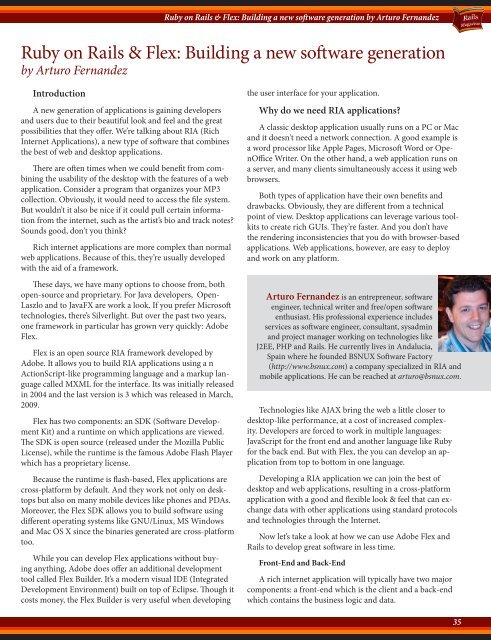Rails Magazine - Issue 3
Rails Magazine - Issue 3
Rails Magazine - Issue 3
You also want an ePaper? Increase the reach of your titles
YUMPU automatically turns print PDFs into web optimized ePapers that Google loves.
Introduction<br />
A new generation of applications is gaining developers<br />
and users due to their beautiful look and feel and the great<br />
possibilities that they offer. We’re talking about RIA (Rich<br />
Internet Applications), a new type of software that combines<br />
the best of web and desktop applications.<br />
There are often times when we could benefit from combining<br />
the usability of the desktop with the features of a web<br />
application. Consider a program that organizes your MP3<br />
collection. Obviously, it would need to access the file system.<br />
But wouldn’t it also be nice if it could pull certain information<br />
from the internet, such as the artist’s bio and track notes?<br />
Sounds good, don't you think?<br />
Rich internet applications are more complex than normal<br />
web applications. Because of this, they’re usually developed<br />
with the aid of a framework.<br />
These days, we have many options to choose from, both<br />
open-source and proprietary. For Java developers, Open-<br />
Laszlo and to JavaFX are work a look. If you prefer Microsoft<br />
technologies, there’s Silverlight. But over the past two years,<br />
one framework in particular has grown very quickly: Adobe<br />
Flex.<br />
Flex is an open source RIA framework developed by<br />
Adobe. It allows you to build RIA applications using a n<br />
ActionScript-like programming language and a markup language<br />
called MXML for the interface. Its was initially released<br />
in 2004 and the last version is 3 which was released in March,<br />
2009.<br />
Flex has two components: an SDK (Software Development<br />
Kit) and a runtime on which applications are viewed.<br />
The SDK is open source (released under the Mozilla Public<br />
License), while the runtime is the famous Adobe Flash Player<br />
which has a proprietary license.<br />
Because the runtime is flash-based, Flex applications are<br />
cross-platform by default. And they work not only on desktops<br />
but also on many mobile devices like phones and PDAs.<br />
Moreover, the Flex SDK allows you to build software using<br />
different operating systems like GNU/Linux, MS Windows<br />
and Mac OS X since the binaries generated are cross-platform<br />
too.<br />
While you can develop Flex applications without buying<br />
anything, Adobe does offer an additional development<br />
tool called Flex Builder. It’s a modern visual IDE (Integrated<br />
Development Environment) built on top of Eclipse. Though it<br />
costs money, the Flex Builder is very useful when developing<br />
Ruby on <strong>Rails</strong> & Flex: Building a new software generation by Arturo Fernandez<br />
Ruby on <strong>Rails</strong> & Flex: Building a new software generation<br />
by Arturo Fernandez<br />
the user interface for your application.<br />
Why do we need RIA applications?<br />
A classic desktop application usually runs on a PC or Mac<br />
and it doesn't need a network connection. A good example is<br />
a word processor like Apple Pages, Microsoft Word or OpenOffice<br />
Writer. On the other hand, a web application runs on<br />
a server, and many clients simultaneously access it using web<br />
browsers.<br />
Both types of application have their own benefits and<br />
drawbacks. Obviously, they are different from a technical<br />
point of view. Desktop applications can leverage various toolkits<br />
to create rich GUIs. They’re faster. And you don’t have<br />
the rendering inconsistencies that you do with browser-based<br />
applications. Web applications, however, are easy to deploy<br />
and work on any platform.<br />
Arturo Fernandez is an entrepreneur, software<br />
engineer, technical writer and free/open software<br />
enthusiast. His professional experience includes<br />
services as software engineer, consultant, sysadmin<br />
and project manager working on technologies like<br />
J2EE, PHP and <strong>Rails</strong>. He currently lives in Andalucia,<br />
Spain where he founded BSNUX Software Factory<br />
(http://www.bsnux.com) a company specialized in RIA and<br />
mobile applications. He can be reached at arturo@bsnux.com.<br />
Technologies like AJAX bring the web a little closer to<br />
desktop-like performance, at a cost of increased complexity.<br />
Developers are forced to work in multiple languages:<br />
JavaScript for the front end and another language like Ruby<br />
for the back end. But with Flex, the you can develop an application<br />
from top to bottom in one language.<br />
Developing a RIA application we can join the best of<br />
desktop and web applications, resulting in a cross-platform<br />
application with a good and flexible look & feel that can exchange<br />
data with other applications using standard protocols<br />
and technologies through the Internet.<br />
Now let’s take a look at how we can use Adobe Flex and<br />
<strong>Rails</strong> to develop great software in less time.<br />
Front-End and Back-End<br />
A rich internet application will typically have two major<br />
components: a front-end which is the client and a back-end<br />
which contains the business logic and data.<br />
35<br />
35


